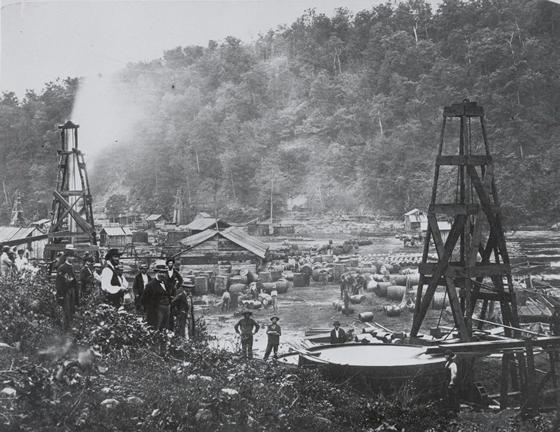
While most of us think of the petroleum age starting in the late 1850s, when North America’s first oil well began gushing oil, human use of petroleum actually goes back much further.
Asphalt, a heavy constituent of petroleum , was used four thousand years ago in constructing the walls of Babylon. During the Roman era, oil was collected and used in the province of Dacia (now Romania), where it was referred to as “picula.”
The first oil wells are believed to have been drilled in China around 350 AD; these wells were drilled using bits attached to bamboo poles and extending as deep as 800 feet. That oil was burned to evaporate brine to produce salt. By the 10th Century the Chinese even built bamboo pipelines to transport oil from those wells to salt springs where the brine was collected. In Japan, petroleum was used for lighting at least as far back as the 7th century. Baghdad’s first streets were paved with asphalt. Marco Polo described oil fields in what is now Azerbaijan, where naphtha was produced. And in the 9th century, petroleum was distilled by the Persian alchemist Muhammad ibn Zakariya Razi into kerosene that was used in lamps.
The first North American reference to petroleum was in 1595 when Sir Walter Raleigh wrote about Pitch Lake on the Caribbean island of Trinidad. With a surface area of about 100 acres and a depth as great as 250 feet, this is the world’s largest natural deposit of asphalt; it is a significant tourist attraction, and asphalt from this deposit has long been exported–some was used in early paving of some New York City streets.
The modern oil industry began in the 1850s. In 1853, the world’s first commercial oil well was drilled in Poland and the second was drilled in Romania in 1857. An oil well in Oil Springs, Ontario in 1858 was the first in North America, and that was followed in 1859 with the famous oil well in Titusville, Pennsylvania, when Edwin Drake drilled a 69-foot well that yielded 25 barrels per day.
Petroleum production in the U.S. increased steadily during the first 50 years of production: 2,000 barrels in 1859, 4.2 million barrels in 1868, 20 million barrels in 1879, 35 million barrels in 1889, 57 million barrels in 1899, and 126 million barrels in 1906.
Through the 1800s, most oil was used for oil lamps and kerosene lamps–replacing whale oil, which was becoming scarce by then. By the early years of the 20th century, though, development of the internal combustion engine shifted demand of petroleum products to automobiles–the market that has driven demand ever since.
With the rise of the automobile in the early 1900s and its use of gasoline–a mix of hydrocarbon refined from crude oil–production of petroleum increased dramatically. World oil production today totals 31 billion barrels per year–almost exactly 1,000 barrels per second!
In the U.S., approximately 72% of our petroleum is used for transportation (gasoline, diesel fuel, and aviation fuel), with the rest used for heating oil, industrial processes, petrochemical feedstocks, lubricants, asphalt, electricity generation, and other uses.
Contact Us to ask a question, provide feedback, or report a problem.


